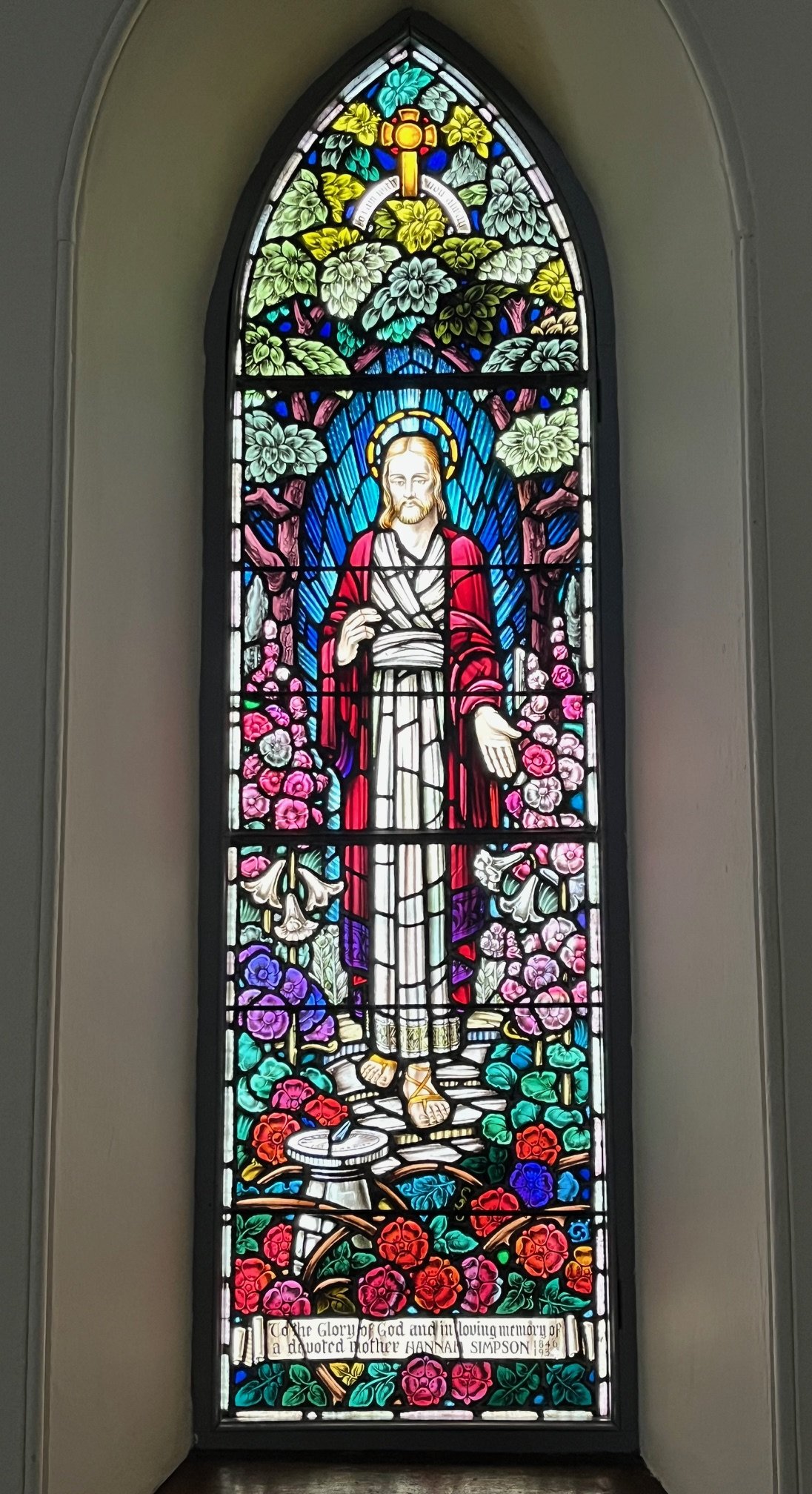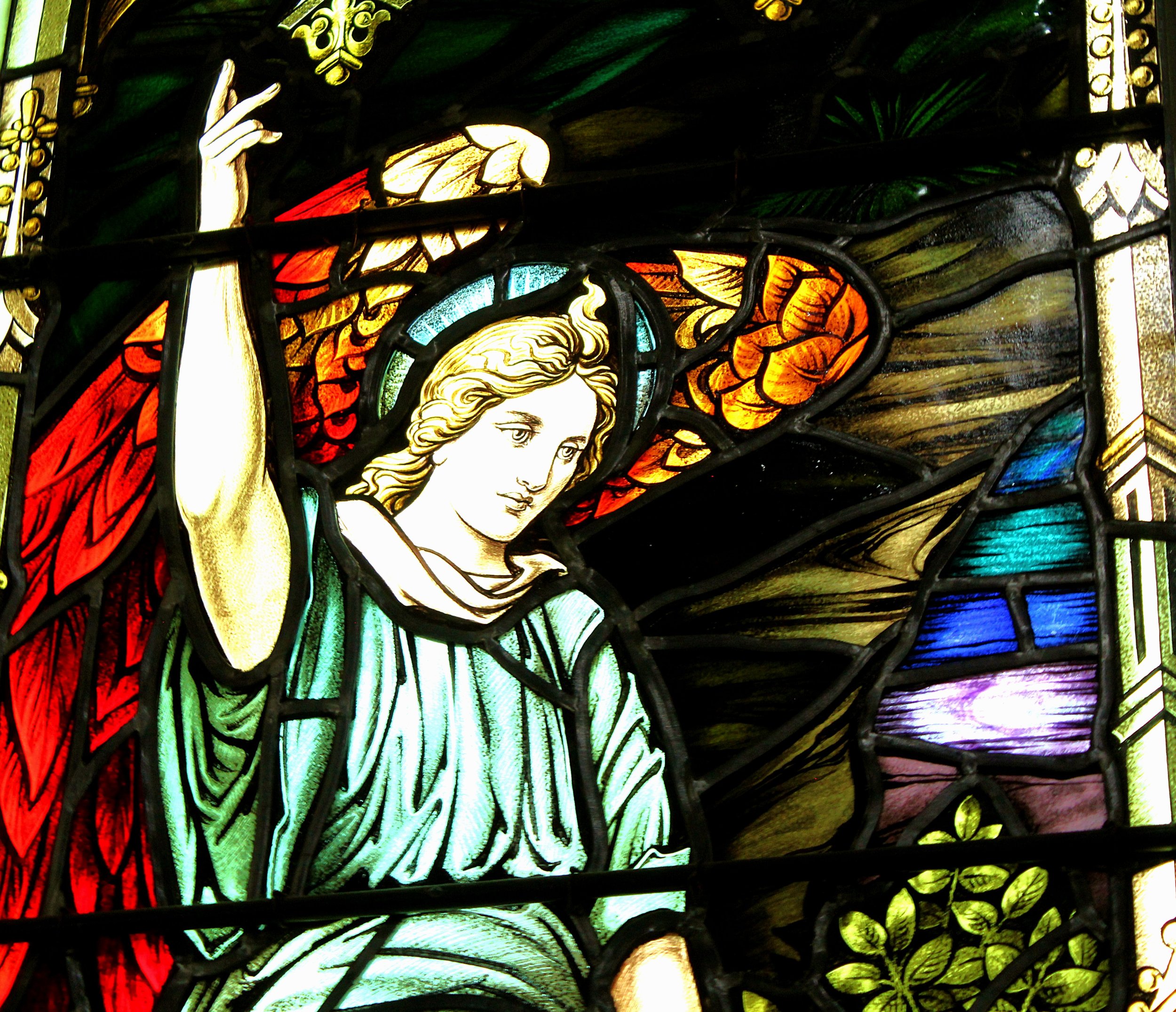Stained Glass: The Art of Remembering
The architects of Upper Canada’s churches in the early nineteenth century followed the Romantic Movement with a classic Gothic design for their building of praise and prayer. Christ Church is a perfect example of this style with its signature large gothic window that faces the beautiful Otonabee River. Its larger replacement in 1866, St. John the Baptist Anglican Church (designed by Samuel Strickland’s son, Walter) was built on the ‘V’ at which Queen Street and Regent Street meet. This building, which is of the pointed Gothic style, is built of squared granite with the windows and doors finished in limestone. Inside are many memorials which recognize the life and service of many former parishioners, including the nine beautiful stained glass windows.
The original purpose of church stained glass windows was to tell the Christian story to those who could not read it for themselves. Visual ‘bibles of the illiterate’, the narrative scenes depicted were to teach the viewers the biblical stories and truths basic to their faith and to provide examples of moral behaviour. With sunlight passing through the coloured glass and filling the interior of the church with ever-changing gem-like hues, it was believed that the viewer’s thoughts would also be elevated to a meditation on divine perfection and beauty. In addition, stained glass in the early days of Canada was a tangible link to a continuing tradition and history - a tie to the homeland. Memorial windows proliferated and became an outlet for a family’s grief and a means to honour their loved ones.
When you step into St. John’s church, you are immediately struck by the collection of stained glass windows. The majority were designed and made by Robert McCausland Limited in Toronto. Founded in 1856 by Joseph McCausland, it is the oldest surviving stained glass studio in North America. His son Robert was the artist who made the firm`s reputation in stained glass. Trained in England, he brought a stream of skilled English artisans to Toronto and became the preferred Canadian stained glass maker for Anglican churches in Ontario. He was known for producing windows ‘in the English style’, a term given to windows radiantly light in colour and harmonized with the architecture of their setting.
For over 75 years the figure of the patron saint of St. John’s, John the Baptist, was the central panel in the three stained glass windows of the chancel behind the altar. Erected during the early 1880’s, this imposing window was a memorial to two infant children - Kathleen Strickland and Thomas Bowker.
Kathleen Irene Sylvia Strickland was born in 1874, the daughter of Alicia Madelena Clementi Smith and George William Ross Strickland. A granddaughter of Samuel Strickland, Kathleen passed away at age 3 months from congestion of the brain (cerebral hemorrhage or stroke) and is buried in Christ Church cemetery.
Thomas William Bowker was the son of Francis Bowker and Margaret Ellen Peed. He was born on January 31, 1879 and died on August 23, 1879 from dysentery (diarrhea). Thomas is also buried in Christ Church cemetery beneath one of the four small white marble crosses that stand side by side on the south side of the church. Sadly, in the span of just seven years, from 1874 to 1881, the Bowker family buried four of their infant children.
This stained glass window that commemorates the two infants was never popular with many of the members of the congregation. In 1899, an article written about the parish contains this description of the John the Baptist window -
“The effect of which is rather spoiled by the figure of John the Baptist in the middle of it. The execution cannot be complained of; it is rather the conception which fails to meet approval, owing to the lack of dignity in the figure, and power in the face.”
In 1903, a carved oak reredos (an ornamental screen covering the wall at the back of an altar) was installed in memory of Henry J. LeFevre and his wife Agnes Strickland Tully. This concealed the legs of John the Baptist, but apparently this was not enough and for several years a curtain hung behind the reredos completely concealing the figure in the window. In the 1940’s a parishioner wrote:
“Between you and me, I don’t think they showed very good taste. St. John the Baptist is very ugly - he has long, boney, crooked legs.”
Finally, in 1964, St. John the Baptist was moved with the unanimous approval of the congregation to a less conspicuous window at the rear of the church. That same year, the figure of Christ as the Good Shepherd was installed as the focal point in the chancel windows. It was given in memory of the Rev. Walter J. Creighton (incumbent from 1906-09 and 1927-1938) and his wife Helen by their daughter and son-in-law, Margery and George Gosling.
The beautiful old stained glass in the side sections of the chancel window trilogy are believed to have been donated by the Nicholls family of Peterborough who gave money to several area churches for this purpose. They too were removed and placed in the two windows on either side of the sanctuary as they were not thought to be complimentary to the new Creighton window. This made room for two new memorial windows.
In September 1973, new stained glass memorial windows designed by McCausland’s were dedicated in the church. One window, incorporating a lamp of learning is in memory of Gordon Winder Smith, former rector’s warden and headmaster of Lakefield College School. The second window with a music symbol, the lyre commemorates my grandmother, Mrs. Wilhelmina Twist, a former organist for thirty years and active church member for over fifty years.
Two earlier McCausland stained glass windows facing Regent Street were commissioned by Edith Daubuz. Installed in 1932 in memory of her parents, Henry James Daubuz and Mary Isabella Daubuz, the first window is a colourful depiction of ‘the resurrection angel’. Henry was a student at Samuel Strickland’s farming school who would later become his business associate. The other window beside it, called ‘the light of the world’, honours Edith’s sister, Magdaline Louisa Wilmot Daubuz, and was set in place in 1933.
I grew up in St. John’s in the 1960’s and the stained glass window that held a particular fascination for me was the window facing Queen Street at the end of our regular pew. Dedicated to Hannah Simpson (1846-1934) and entitled ‘Christ in the garden,’ it is an explosion of colourful, and to me as a young girl, magical flowers. The Simpson family settled here in the 1830’s and two succeeding generations worshipped in St. John’s. A writer for the Mail and Empire at the turn of the 20th century sang the praises of this particular stained glass window in St. John’s.
“Through the window whose central light bears the figure of the young preacher in the wilderness, touching the blueness of the blossoms into living azure and gilding the tablets put up to the glory of God and the memory of those who have passed away.”
All nine of these wonderful stained glass windows are a marvel to behold and a testament to those who have gone before us. These windows are always changing with the light, providing a discovery of some new detail never before noted. They serve as a lasting tribute to beloved members of our community and to the artists who designed them.
This article originally appeared in a February 2024 edition of the Lakefield Herald and is gratefully republished here with the permission of its author, Chair of the Christ Church Community Museum Patti McAllister.




